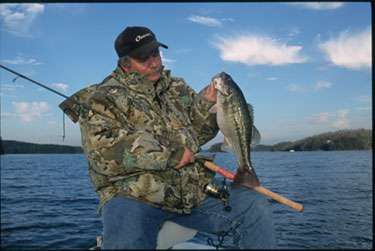
Put away your Metallica albums, the heavy metal we're talking about here consists of jigging spoons, blade baits and tailspinners. Save the headbanger music for your iPod or home stereo. Besides, the vibrations might scare the fish.
Let's start with jigging spoons.
Spoons are among the oldest lures in the fishing world. Some archeologists maintain that spoon-type lures have been around for about 5,000 years, but the first "modern" spoon lure is generally attributed to an angler named Julio Buel, who supposedly dropped the spoon he was using to eat his lunch into the water and watched a fish grab it.
That allegedly happened in 1811. Buel hustled home and started doing all manner of destruction on his household cutlery and dinnerware. Today we're fortunate that tackle companies do such dirty work for us.
Randy Edwards is a Lake Lanier, Ga., bass guide who has been spoon-feeding winter bass for decades. Once water temperatures bottom out, he knows that spoons and a vertical presentation are the key to catching great numbers of bass when most anglers are struggling.
"There's really no magic to fishing a spoon," Edwards says, though in his hands the slab of shiny lead with a treble hook will catch more bass in a few hours than other anglers may see all month. "You just have to pinpoint the fish and get the bait down to the right level."
Edwards uses a variety of jigging spoons but likes the old Hopkins Shorty 75 (3/4-ounce) as well as any for most of his spooning.
"You need a spoon that matches the size of the dominant baitfish and that will get down quickly to where the fish are," he says. "I recommend a slab spoon rather than one with lots of curves and a concave shape. Those concave spoons flutter all over the place and will get hung up too easily."
Edwards is a master with his Lowrance electronics and looks for schools of baitfish with bass positioned underneath or beside them. When he finds this situation, he knows he's about to get very busy catching fish.
"These wintertime bass schools are where you find them. Sometimes they relate to structure like a creek channel or bluff, but other times they use the school of shad or baitfish as their structure. The ideal situation to find is one in which the bass are already feeding on the shad. You know you're going to get bit right away then."
Dropping his spoon into the feeding bass or to the bottom of the school, Edwards then sharply lifts the rod to make the spoon rise up. He only does this so it will fall again, knowing that's when the strike will occur.
"A big key to spoon fishing is to make sure that you never let the spoon fall below the bass," he says. "You want it to look like a dying or injured baitfish, and if it's jumping around all over the place down there, it doesn't look right."
If the productive depth range is very specific, Edwards will mark his line with an indelible marker so he won't go past the proper depth. Other anglers choose to do their spoon jigging with older style reels like the Ambassadeur 5500s. They count the passes of the level wind mechanism across the spool to determine how much line is out.
A final tip that Edwards has for spoon jiggers involves color. Most spoons come in silver or chrome, which does a great job of mimicking shad, but may not match the bait in your lake.
Edwards will add color to his spoons with highlighter pens or, when a really different look is needed, by inserting the spoon inside a tube bait. The tube gives the spoon a translucent look and the tentacles add extra action that sometimes draws extra strikes. Try it, it works.
They joke that you should never bring a knife to a gunfight, but for peace-loving anglers it's even more important to bring a spoon to the lake.




